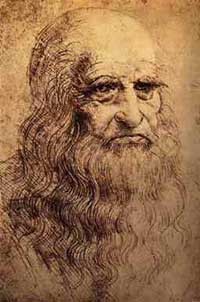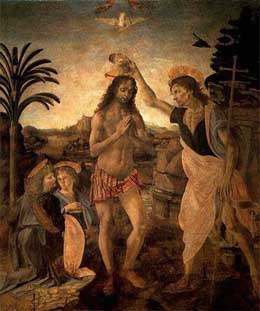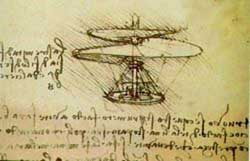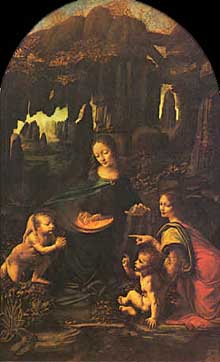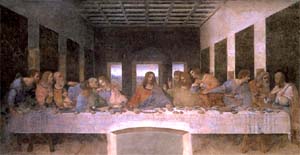pop up description layer
HOME
Cryptozoology UFO Mysteries Aviation Space & Time Dinosaurs Geology Archaeology Exploration 7 Wonders Surprising Science Troubled History Library Laboratory Attic Theater Store Index/Site Map Cyclorama
Search the Site: |
|
Leonardo da Vinci: A Genius Before His Time He was a scientist before there was science, an inventor whose ideas outstripped the technology of his time, and a famous artist who produced the most valuable and recognized painting in the world. Just what do we know about this celebrated Renaissance man of mystery? Ser Piero di Vinci didn't know what to do about his son, Leonardo. He had reached the point in life where young men needed to prepare for a career. Ser Piero himself was an important official - a notary. This line of work would be closed to Leonardo. His birth had been the result of a romantic tryst with a peasant girl, too low a class for Ser Piero to consider marrying. Because the boy was illegitimate, the guild of magistrates and notaries would not accept him,. nor would he be allowed to attend the university. The boy did show a definite talent for drawing, however, perhaps he could be apprenticed to an artist… This is how young Leonardo da Vinci started on his career in art, a career in which he would create some of the most famous paintings in the world, including perhaps the most-widely recognized and most highly valuable painting of all time, the Mona Lisa. Leonardo da Vinci was more than just an artist, however. He was also interested in science, anatomy and architecture. His sketchbooks, filled with his ideas for inventions, stunned the world when they were found centuries after his death. Leonardo was born in or near the Italian town of Vinci on April 15, 1452. He probably spent the first few years living with his mother, but moved to his father's house when she married. We know that by 1457 he was living there because his name appears in tax records. His father was stern and distant with him, but Leonardo was a favorite with his uncle, Francesco, who ran the family's farm. Some time between the age of fifteen and eighteen Leonardo was apprenticed to the artist Andrea di Cione, called Verrocchio (which means "true eye") in his studio in Florence. Painter in Florence
Verrocchio was one of the leading artists in the city and Leonardo turned out to be an excellent student. He learned to make brushes and mix colors as well as to draw, paint and sculpt. In those days when an artist was commissioned to make a piece of art, his apprentices would help do the work. It was said that when Leonardo was given the assignment of painting an angel in one of the master's pictures, his work was so much better than the rest of the painting that Verrocchoio put down the paintbrush and never picked it up again. At age twenty Leonardo was accepted into the painter's guild. While he quickly got a reputation for doing fine work, he was also labeled as an artist that never finished what he started. This was a charge that was to follow him most of his life. While he loved the challenge of painting, his interest in the project would wane after the initial sketches were completed and the actual drudgery of carefully painting brush mark after brush mark started. Some attributed this to the wide range of Leonardo's interests: Why should he be working on a boring painting when he could be studying nature? Sketchbooks It was during this period that we have the first records of Leonardo starting to record his observations about nature, architecture and anatomy into his sketchbooks. Apparently Leonardo started keeping a sketchbook to improve the quality of his paintings. He would dissect human and animal bodies to better understand how the muscles and bones inside shaped the skin. His books contained almost 200 carefully-drawn anatomical pictures of the human body. He also went into the countryside and studied the features of plants and the geology of rocks, recording them in his sketchbook. These fine details later emerged in some of his most famous paintings. Over his career, though, these sketchbooks became more than just ways to improve his art. They were filled with pictures and notes attesting to Leonardo's wide variety of interests and his depth of understanding. Many of the pages included ideas for inventions. Some were improvements to existing machines, others were wholly new and ranged from a primitive tank to a human powered flying machine.
Leonardo was not, by the standards of his day, an educated man. He did not attend a university and he never got formal training in Latin. This limited his ability to read the classical texts. This deficiency may actually have been an advantage, however. In those days scholars had the habit of answering questions about nature by reading what the classical philosophers said about the subject. Leonardo, perhaps because of the language barrier, went out and observed nature himself, drawing his own conclusions based on what he saw. He made hypotheses' about what he found and in some cases set up experiments to test his ideas. He was using the scientific method before it was invented. Working in Milan Work in Florence was slow, so in 1481 Leonardo decided to move to Milan. He knew that Duke Ludovico Sforza (also known as "The Moor" because of his dark complexion) ruler of the Duchy of Milan, was concerned about the defense of the city, so he wrote the Duke a letter. In the letter, which Leonardo addressed to the "Most Illustrious Lord," he claimed to have studied all of the latest engines of war and come up with many improvements for them, some of them secret. He wrote that some of his designs included bridges that were light to carry but very strong, better mortars, catapults, and techniques for digging tunnels and drying up moats. He also alleged he was an architect capable of building canals and other structures. Finally, almost as an afterthought, he added, "I am able to execute statues in marble, bronze and clay; in painting I can do as well as anyone else."
While he was waiting for Ludovico to make his mind on his proposal, Leonardo accepted a commission to paint an altarpiece for the church of San Francesco Grande in Milan. The monks who commissioned the work spelled out in detail what they expected to see when the artist was done, including the characters in the painting and what they should be wearing. Leonardo signed the contract, but completely ignored its contents. What Leonardo produced, however, was undoubtedly a masterpiece. He dispensed with such conventions as halos and produced an extremely natural-looking picture compared with what other artists were doing. A careful study of nature can be seen in the rocks and plants that surround Mary, the baby Jesus, the baby St. John and a watching angel. By not giving objects in the picture a sharp outline but letting them flow together through the use of shadows he gave the painting a three-dimensional effect like no other artist had ever before achieved. This work apparently impressed Ludovico enough that he hired Leonardo to work for him. Leonardo's assignments from the duke included designing a heating system for the duchess's bath, overseeing the molding of cannons, engineering canals, supervising pageants and decorating the ceiling of a room in the palace with a painting of a grove of trees. Probably his most difficult assignment was a giant horse. Ludovico wished to have a statue of a rider on a horse erected to commemorate his father, Francesco Sforza. He gave this project to Leonardo who worked off and on on it for sixteen years. Leonardo spent much time studying horses, sketching them, and even dissecting dead ones in order to understand how the statue should be made. Finally, in 1493, he produced a full-size clay model that was 24 feet high. His idea was to start with the horse and add the rider later. While the molds were prepared and the bronze gathered, Leonardo worked out a way of pouring the metal quickly so it would not crack as it cooled, which was problem with such a huge statue. At the last minute, however, Ludovico decided he needed the bronze more for cannons than for the statue, and the project was never completed.
The Last Supper It was while he was in Milan that Leonardo painted one of his most famous works, The Last Supper. This painting, depicting the last Passover dinner for Jesus and his disciples, was to be done on a wall of the monk's dining hall at Santa Maria della Grazie. The work was to be done as a fresco. Fresco is a technique for painting on walls where the artist lays down a layer of plaster and then brushes onto it water colors. The painter is limited to a certain range of colors and must work quickly before the wall dries. Leonardo simply could not work fast enough (the painting, much to the distress of the monks, took him four years to complete, starting in 1495) so he came up with his own experimental method that would allow him to add changes days or even years later. Leonardo chose to have the disciples using the same type of tables, plates, glassware and tablecloth as the monks used, giving the impression that they were eating right alongside the others in the hall. Leonardo's work habits drove the monks crazy. He might labor on the piece all day without a break, then leave and not be seen for the rest of the week. He was observed on one occasion staring at the painting for several hours, then making one or two tiny brush strokes, then leaving. It is said that Leonardo spent days haunting the streets of Milan looking for a subject with an evil enough looking face to use as a model for Judas. When the Prior (the head of the monastery) complained about Leonardo's work ethic, the artist threatened to use the Prior's face as the model. "Until now I held off holding him up to ridicule in his own monastery!" Leonardo supposedly commented. The painting was finally completed in 1498, but unfortunately the experimental method Leonardo used to prepare the wall failed. Even before his death, flakes of pigment were falling off the wall. The Battle of Anghiari In 1499 French troops invaded Milan. Ludovico fled the town and Leonardo lost his patron. For the next 16 years Leonardo moved through Europe working for various people including the notorious Cesare Borgia who was intent on conquering central Italy. Leonardo was employed by Borgia as a military engineer. It was at this time he became friends with a Florentine diplomat named Niccolo Machiavelli who later on wrote the famous book The Prince. Machiavelli recommended Leonardo for his next job, a painting in the Great Council Chamber at Florence that would depict The Battle of Anghiari. To Leonardo's chagrin, a young rival artist, Michelangelo Buonarroti, was also hired to paint another battle scene, The Battle of Cascina, in the same room. Neither artist finished their assignments. Leonardo's was again the victim of one of his experimental techniques. He tried to avoid fresco once more and use oil paints on the wall. His idea was to dry the paint by using the heat from a fire. Although this worked in his workshop, the results in the Council Chamber were uneven and the fire blackened the top of the picture. Discouraged, Leonardo gave up and could not be induced to finish the painting. Eventually what he had completed so far was painted over. We only have an idea of what it looks like now based on preliminary sketches made by Leonardo and copies produced by other artists before it was destroyed. This period in his life was a difficult time for Leonardo. After his father died, a dispute with his half-brothers and sisters deprived him of his portion of his father's estate. The same thing nearly happened when his uncle died and left all his wealth to Leonardo. After a protracted court battle Leonardo did win the right to use his uncle's money and lands, but only for his own lifetime. Mona Lisa
Out of this difficult period, however, came what is his most famous work, and perhaps the most well-known painting of all time: The Mona Lisa (also referred to as La Gioconda). It is thought that this painting was started in 1503 and depicts the third wife of a Florentine silk dealer named Francesco di Bartolommeo di Zanobi del Giocondo. For some reason, perhaps because Leonardo liked it so much, it was never sold to the person who ordered it. The painting shows a young woman seated on a terrace giving the viewer an enigmatic smile. Leonardo used a technique of smudging the paint (called sfumato) near the end of the lips and the corner of the eyes to fool the viewer. Her exact expression eludes the observer, changing as he moves his eyes over the portrait, and this makes the subject almost seem to be alive. Around 1516 or 1517, Leonardo's fortunes changed again. The King of France, Francis I, offered him the position of Premier Painter and Engineer and Architect of the King. Leonardo happily accepted this assignment and traveled to France. There he was installed in the manor of Cloux near the Royal chateau. Leonardo brought two apprentices with him, Salai and Melzi, who, because Leonardo had never married or had children, were like sons to him. He also brought the Mona Lisa with him as well as two other paintings, a picture of John the Baptist and the Virgin and Child with St. Anne. Leonado spent his last few years in comfort. His duties for the King were light and they would spend long hours in conversation. He stayed in the King's service until his death on May 2, 1519 at the age of 67. It is said, though scholars have disputed this, that he died in the arms of the king of France. After his death, the Mona Lisa made its way into the King's hands and is now enshrined in the Louve in Paris A Partial Bibliography Leonardo da Vinci by Diane Stanley, Morrow Books, 1996. Leonardo da Vinci by Sherwin B. Nuland, Penguin Lives - Lipper Viking Books, 2000. Leonardo da Vinci by Marin Kausal, http://www.kausal.com/, 2004. Copyright Lee Krystek 2005. All Rights Reserved. |
|
Related Links |
|
|



